Struggling to find great content to share on social media? Feel as if you're endlessly searching for that perfect piece of content? If you've felt overwhelmed by planning, organizing, and posting to social media, you need a calendar.
But I get it. Creating a social media calendar from scratch can feel daunting. To help you get started, I’ve documented the exact strategy I’ve followed for years. Below, you'll discover how to set up a social media content calendar, and build a loyal and engaged community.
How a social media content plan helps you succeed
1. Quality isn’t enough
Quality vs. quantity. It's the age-old battle between marketers. Is less really more or is more the new black? Less is more. But only when that content is:
- Relevant
- Valuable, and
- Personalized
56% of marketers believe that personalized content promotes higher engagement rates.' -IBM
Beyond that, it gives your audience important insight into who you are. Now pair your quality content with the right content and you have a winning combo. You also create differentiation. Instead of blending in among the same old posts and tweets, you set yourself apart. You’re defining a niche, creating a voice, and positioning your company as the “go-to” resource.
Think about it this way...The trust your fans and followers feel toward your content translates into trust for your brand and product. And as Ron Guirguis points out in an Edelman Trust Survey,
“People don’t just buy products anymore, they buy the companies that make products, the values they represent and what they stand for.”
Putting a solid social media content plan in place can help you build that trust. It also keeps you top of mind and a top choice when they decide to invest in you or your competition. In other words, your content becomes a bridge, shortening the time between acquisition (awareness) and revenue.
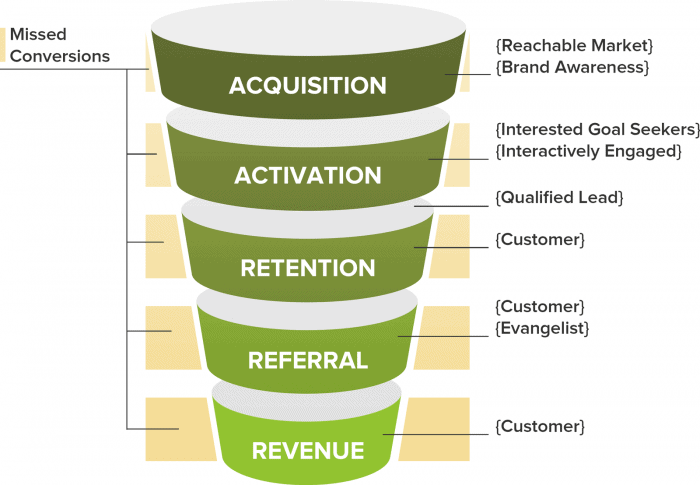
2. Attraction marketing
When you produce quality content, you’re attracting an audience. But what does that matter if it's not an audience ready to take action? Sharing the wrong content with the wrong people means you end up with a whole lot of what you don't want.
The winning combo is when you transition passive readers into prospects, leads, and then sales. If you're currently having trouble with social media conversions, it's more than likely because of this: You've been wasting your time producing and sharing the wrong content.
But the good news is this: You can fix it. And it doesn’t require a ton of time, money or effort. You can right the ship in a few easy steps and get your content on track and engagement humming.
3. A calendar alone won’t save your content
One of the best ways to produce continual content is through a social media editorial calendar. Creating one will act as your daily content guide. Rather than sitting and staring blankly at your computer screen when it comes time to write, your inspiration will have been previously designed.
But a calendar by itself won’t solve your social media engagement issues. Or give you back your day.
The key to making this work is this:
- Clarity - Knowing who your audience is and what problem you solve.
- Purpose - Understanding the purpose of your content. Know why each piece of content supports your business goals and growth.
- Action - A plan without action is, well - just a plan. If you want to create better content, you have to start somewhere.
Creating your content editorial calendar
Step 1: Set goals and make them stick
Before you get to your daily social media tasks, you need to know your goals and objectives. They’ll give direction to your strategy. They also give flight to your ideas. As Thomas Oppong put it (one of my favorite authors on Medium),
“You are judged by your outputs, not your thoughts. It pays to take real action in the direction of your goals.”
So let’s get at it. Set your social media goals and objectives. Visualize them and then turn them into action. Write out the daily steps you will need to take to reach these objectives.
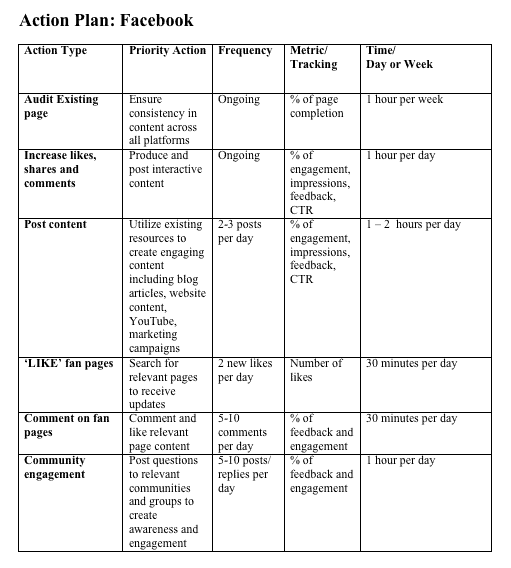
Determine what daily, weekly and monthly social media disciplines will help you reach these goals. Write them down beginning with this process.
Your goals:
What do you want to achieve?
- Increase in Sales
- Drive Traffic
- Improve Customer Experience
- Heighten Brand Awareness
According to a survey by Simply Measured, 71% of marketers surveyed cited “Brand Awareness” as their #1 social media objective.
If it’s yours too, build your objectives around a creative content schedule that maximizes every social network you’re actively using.
Your objectives and tactics:
Now break down those goals into objectives and specific tactics.What will you achieve that will support your overarching goals?

A few examples:
Increase in Sales
- Create 5 specific pieces of content for Facebook and Twitter each week
- Design a Pinterest image for each new blog post
Drive Traffic
- Tweet 1-2 evergreen blog posts to Twitter every day
- Use a CTA (call to action) for blog
Improve Customer Experience
- Shorten normal response time
- Allow for easier access to support
Heighten Brand Visibility
- Use live streaming to connect with a market previously untouched
- Create a new interview series
Write down the areas that need to be improved in order for you to reach your objectives. Set a deadline for each of the objectives and get it into your calendar!
Step 2: Content brainstorming
The most important element as you begin to outline your calendar is determining what topics matter most to your customers. This will require research as you take a deep dive into the wants and needs of your potential clients, buyers, and users.
This is where a tool like Google Analytics becomes your best friend. Identify the top keywords and phrases your audience is actively searching for online. Those terms will then become your weekly social media theme or focus.
Here's how to do that...
Generate content ideas with analytics
Analytics (Google, Facebook, Twitter, Pinterest) are a fantastic source of information (and inspiration). We're going to begin with Google Analytics. Head over to yours and look at:
- What blog posts received the most views.
- Review your top 50 and sort based on the topic. e.g. Facebook vs Twitter
Now ask: is there a chance to --
- Create 10-20 tweets from that content?
- Design images with quotes from your content?
- Write additional content around that topic?
The answer to all of the above is almost always — YES!
This will begin to help you form two things:
- Themes or weekly/monthly social media topics
- An opinion on the type of content most interesting to your audience
Once you know that, you can focus on creating more of what they like (and less of what they don't).
Look at your competition
Don’t limit yourself to your own content – check out the blogs and websites of other people in your industry. See what kind of content your competitors are sharing and which types are getting the most shares.
BuzzSumo is my favorite tool to use and provides a quick snapshot of any topic, keyword, or website. Go to the "Content Research" tab, type in any URL, and then look to the social engagement. Is there a topic that you could write about? If their audience is similar to yours, creating content based on proven performance is a smart move.

Step 3: Determine content types
Probably not a big surprise, but...You can’t randomly share content and hope it produces results. You need to share the type of content that converts.
So, what does that look like? Below are a few content formats guaranteed to convert every time. They focus on the biggest buying triggers like trust, credibility, and reciprocity.
Content formats that convert
- Blog posts
- Webinars
- Ebooks
- Case studies
- Special Reports
- White papers
- Workbooks / Downloads
- Podcast interviews
- Checklists / How-to’s
- Video guides and tutorials
Your next steps:
Choose one at a time. Let me repeat that: One at a time. (this is for all those over-achievers. I see you and know who you are)? Now, determine how that will support your content goals.
Once you've done that, it's time to tackle it. For example: once you’ve tested how webinars work for you, then move on to the next idea. Combining too many ideas at once will cause a couple of things to happen:
- You’ll struggle to keep up with the amount of work it takes to execute each of these ideas
- You’ll have a difficult time tracking which idea has the biggest impact unless you’re running a full scale Inbound Marketing strategy
Here’s a look at a few content formats and how to use them as a brainstorming starting point.
Webinars (Live and recorded)
Webinars are a fantastic way to build a list and sell to it. They're effective for both B2B and B2C marketing. But keep in mind: maximum effectiveness only happens when you provide a serious amount of value. My process for webinars is similar to presentations. (I wrote about it here)
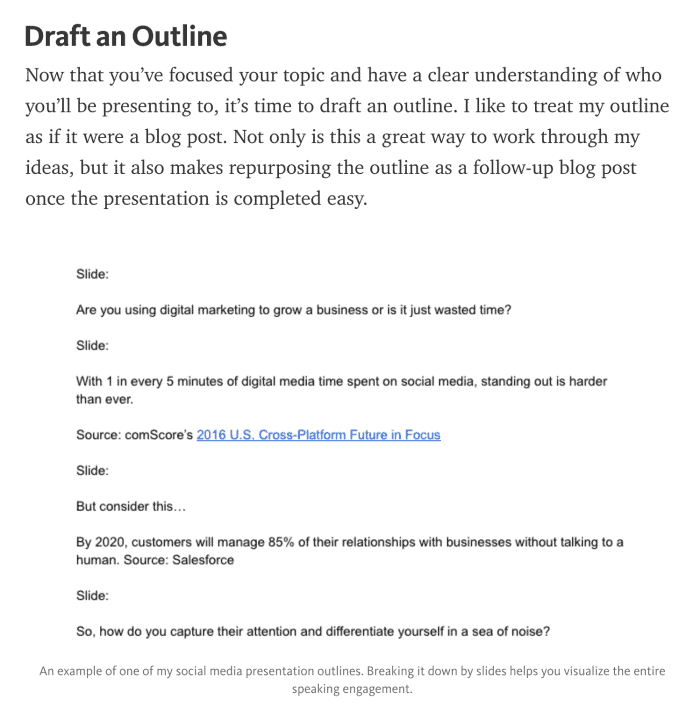
eBooks
eBooks boost your brand’s credibility and move leads through your marketing funnel.eBooks will see the best results if it's a topic relevant to your audience and you're a credible source. Use them as a free offer to guide them into the next steps, build your list, and...Brand your name as reliable, knowledgeable, and trustworthy.

Special reports
The purpose of reports is to help the reader solve a specific problem. For example, if you were a health and diet coach, you could create a report for prospective clients. You would show how to choose the right health coach dependent on specific needs and goals. It would solve the problems of anyone researching health and diet coaches. It will also position the author as a potential choice when it comes time to hire someone.
Workbooks/ downloads
Workbooks or downloads usually go hand in hand with eBooks or reports. They can be a terrific conversion tool. They help the reader take the necessary action and go from a prospect or lead to a real customer. For example, a workbook on healthy eating could complement an eBook on a healthy lifestyle.
The eBook generates new leads, while the workbook or worksheet converts them into customers. The one below is one of my most successful downloads and has moved people from social media goals into content marketing and business goal strategy. Think about the end result you're looking to achieve.

Case studies
Case studies are articles that show the reader how your company solves problems. They focus on the problem itself and explain in detail how you solved it, who you solved it for, and the end result.
Case studies build credibility in B2B or B2C marketing and service-oriented businesses. They can range between 4-40 pages, depending on the type of information they share and the niche.
White papers
White papers are most effective for B2B marketing. They're guides or reports that give the reader all the information they need on a specific issue. While they're nothing new in the online world, their purpose is still beneficial. You want to help your readers understand a specific issue and move them through the decision-making process.
Similar to case studies, white papers start out with a summary and then transition to the challenge. Next, they focus on how the product or service solves this specific problem. White papers end with a conclusion and a call to action that guides the reader towards the next step. They range anywhere from 10 to 30 pages long.
Step 3: Content calendar
Now the fun begins! This step takes the research you’ve done and pairs it with an actionable plan. Creating your content calendar can be as simple or as detailed as you want to make it. You can use Excel, Google Drive, or a Word doc, depending on your comfort level and needs.
STEP 1: Focus on your theme for each week. Your theme is based on your topics and those are associated with the keywords or terms you want to be known for. For example, if you sell jewelry, your topics might be "sterling silver jewelry" or "birthstone jewelry."
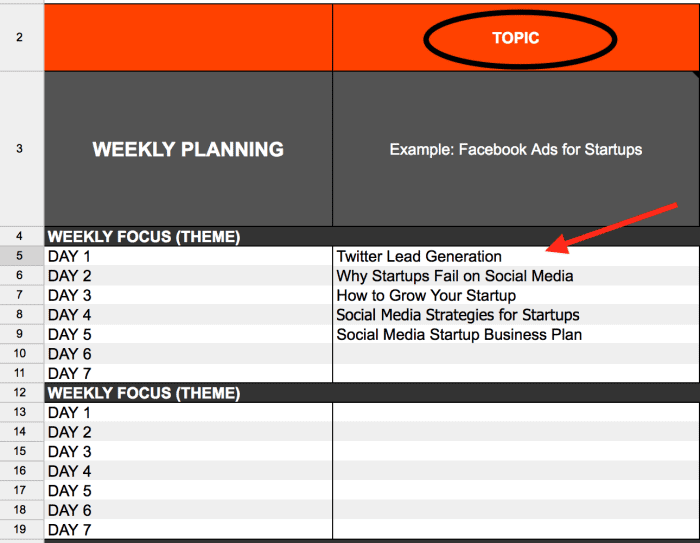
STEP 2: Now you'll take those topics and break them down into a daily focus. Here's how to do this: treat each theme as a content bucket. So let's say content bucket #1 is sterling silver jewelry.
Now write down 5 different questions you can answer around that topic. Add one of those questions to each week in your calendar.
- Example Question: What type of sterling silver jewelry should I buy for my wedding?
- The topic for Your Calendar: How to Choose the Best Sterling Silver Jewelry for Your Wedding
STEP 3: Determine the destination.e.g. Social Network (Facebook, Twitter, Instagram, YouTube, etc)
STEP 4: Call to action and funnel purpose. How will you build awareness, nurture your social media relationships, or activate and inspire them to take action? Know those next steps and include a call to action in each of your posts.
Identify what that action is:
- Click a link
- Opt-in
- Download
- Sign up
- Join a webinar
The options are limitless, but each post needs a clear CTA or you've missed a huge opportunity.
STEP 5: What CTA content you'll include. These are links, images, or videos that share your content in a blog format, landing page, white paper download... you get the picture. Your goal is to add everything that you'll need to keep it right at your fingertips. You don't want to spend time searching for a related item when you're getting ready to post. Simplify by keeping everything in one location.
Step 4: Posting strategy
Once you’ve completed the planning and visualization aspects of your content strategy, it's time to create a posting strategy. This is a checklist of your daily, weekly, and monthly tasks. Decide which social media channels you will share your post across. Create a separate column in your content calendar for Facebook, Twitter, Instagram, LinkedIn, and Pinterest with an example of which type of media you will share. Will you share an image, link, video, infographic, white paper, or free downloadable eBook?
Repurposing your content for social media is a vital piece of the blogging process and must be incorporated into your content calendar. Now it's time to determine how often you'll post.
Look to your analytics for information on when your audience is most engaged and when they're online.
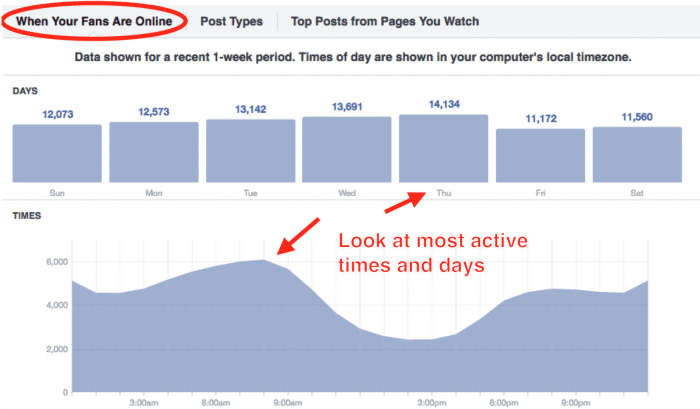
If you need a daily social media checklist, I've created one in an earlier post. Take that and add it to your daily to-do list. And here's a free calendar that will make planning ahead a breeze.
Step 5: Use the right tools
Are you spending more time than you have trying to keep up with social media? If so, you need to incorporate a few automation tools. Automation lets you schedule your posts ahead of time. But more than that, it allows you to get your content in front of your audience when they’re most active.
If you want to know when your best time to post is, you'll need to dig into your analytics. Armed with that information, you can make data-driven decisions. True Social Metrics is a tool I use daily to better understand when and how my audience is spending their time online.
Analyzing the data lets you see when your customers are interacting with you online. Rather than throwing posts out, hoping for an outcome, you predict it with data.
Once you know your best times to post, take those, and add them to your favorite social media management tool. For me, that’s Agorapulse and Sprout Social. In Agorapulse, I can add those times to my Queue. Now here’s where the automation comes in.
When I add content into my Queue, it’s scheduled based on those pre-determined times. It also sorts based on the type of content.
No dragging and dropping or scheduling. Just add my favorite content and let the system do the heavy lifting. Pretty cool, right?
Sprout Social has a similar feature. Add your perfect times to post to your Queue and drop your content in.
Final thoughts
Is your social media content turning your readers and fans into contacts, leads, and sales? If not, it's time to get strategic with the content you're sharing. When you create the right content and share it at the right time with the right people: You begin to grow a loyal following...And that is the start of a beautiful relationship.
About Rebekah Radice
Rebekah Radice, co-founder of BRIL.LA, has traded narcissism for purpose. When not driving growth, you'll find her tricking family into thinking she's Emeril Lagasse - likely covered in marinara. The spotlight was fun, but impact is better. These days she's using 20+ years of brand brilliance for good.
